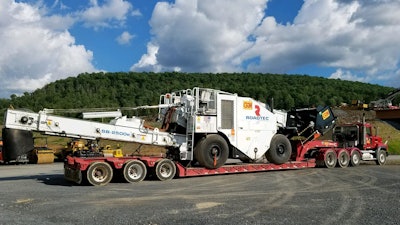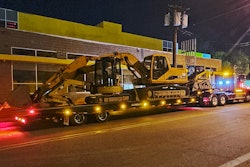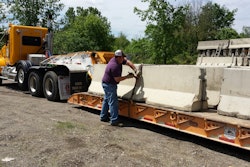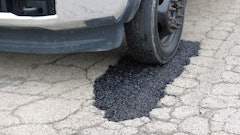
Transporting paving equipment to and from the jobsite safely and efficiently can be a logistical and financial challenge. That’s why selecting the right trailer for hauling paving equipment isn’t a decision to be taken lightly. Many hours of research are required to find the trailer that fits an operation’s needs. It’s a long process, but the end result is — hopefully — an implement that will provide safe, efficient hauling for years, benefiting the operation’s bottom line for the long haul.
Just as there are many considerations to make when investing in paving equipment, selecting the ideal trailer to fit all of an operation’s hauling needs means taking a critical look at several key variables. Keep these five factors in mind when sizing a trailer for paving equipment loads.
1. Equipment Weight and Dimensions
The first step in sizing a trailer for any hauling job is determining the weight and dimensions of the load. Identify the length, height, width and weight of your most challenging machines. Keep in mind that the information on the spec sheet might not include the dimensions and weight with added accessories.
When making initial calculations, ensure you have a suitable truck that is capable of handling all or most of your equipment before moving on to the trailer. A three-axle tractor and a four-axle tractor will have different hauling capabilities and that varies by state.
There is a wide range of machinery used in the paving industry — such as pavers, rollers, milling machines and screeds. Each of these machines are different by design, so proper research on the specific requirements of each intended machine is highly recommended. Certain paving equipment will require a lower load angle as opposed to other equipment.
After determining the weight and dimensions, it’s time to look at trailer deck designs. Manufacturers usually offer three deck configurations — flat, raised center and beam. For the most part, operators looking to haul paving equipment will find a flat deck meets the majority of their needs. It offers the most versatility for moving a variety of equipment, from rollers to milling machines. However, it also has the highest deck height and might not be ideal for those also looking to haul taller machines. For this reason, discussing the pros and cons of different deck designs with a professional is recommended when spec’ing a trailer.
Custom heavy-haul trailer manufacturers have the experience and knowledge to determine what style would be best overall. While the primary focus might be on paving equipment, a trailer often hauls a variety of equipment types. Backhaul equipment should also be included in calculations. An expert can determine the best trailer to meet all hauling needs.
In addition, companies today tend to specialize in a wider variety of equipment moves that might require special considerations when it comes to selecting a trailer. For instance, operators looking to haul excavators in addition to paving equipment should research configurations that accommodate the boom. In these cases, operators need to consider the length of the boom, where it will sit on the trailer and how it will be cradled in addition to hauling needs for their paving equipment. Some top-tier manufacturers offer customizations to make mixed-load transportation safer and easier. Knowing all the types of equipment that might be hauled will help ensure purchase of a suitably versatile trailer.
2. Trailer Capacity Rating
While knowing the overall weight of the equipment is imperative, it is also important to know where that weight is concentrated. Failing to be mindful of this can lead to overloading the trailer, which can result in stress fractures and ultimately trailer failure.
Just because a trailer is rated at 50 tons does not mean it can be loaded with 50 tons of cargo in any configuration; operators need to consider the deck length used in the capacity rating to determine if the trailer is suitable for the proposed load. This varies between manufacturers. One trailer might need the entire deck length for that 50 tons, while another handles that same weight in half the deck length. Similar-sized paving equipment can have drastically different load concentrations. If the majority of the equipment’s weight is concentrated in 8 or 10 feet, a trailer with a half-deck load concentration rating offers the best solution.
3. Loading Configurations
Today’s trailers offer a variety of loading configurations. While tag-a-long trailers that unload off the back are an accepted option for small paving in tight spaces, safety can be a concern. Driving equipment over the back of the trailer is no easy feat and requires a careful and experienced driver to prevent damaging the trailer and minimize the risk of tipping equipment. Reputable manufacturers are safety minded and have implemented designs to minimize certain risks, such as roller stops at the rear of the trailer or extended ramps for lower-approach angles.
Removable goosenecks reduce the danger by eliminating the need to drive up and over the trailer axles. This configuration saves time, hassle and expense while also extending trailer life. However, a removable gooseneck requires ample space for loading and unloading.
4. State and Federal Regulations
Knowing where a trailer is headed is as important as knowing what it’s hauling. In general, operators should not need additional permits for loads up to 102 inches wide and under 13 feet, 6 inches tall. However, weight and height regulations vary for bridges and between states, especially trailers hauling in California and the surrounding areas. Operators must also consider state kingpin laws. Working with an experienced manufacturer will ensure a wealth of knowledge and expertise when it comes to making sure trailers and loads are safe and compliant for each area of operation.
5. Trailer Construction
It’s important to consider the quality of a trailer, not just the price tag. Working with a custom manufacturer offers the best results when it comes to safety, value and peace of mind. A trusted manufacturer will work to understand the client, not just the load. They will consider not just the equipment, but everything the client needs to haul, the territories of operation and the specific challenges they face. The manufacturer will use that information to design a trailer that offers maximum flexibility, versatility and strength.
Also consider the construction materials. Look for materials like heavy-duty T-1, 100,000-psi minimum yield steel for extreme durability and longevity. Apitong flooring is another good choice because it stands up better than traditional oak and pine decking. Investing in higher-quality materials and components can double the life of the trailer.
Trailers from a respectable manufacturer may also include positive camber in the design. The amount of camber can be customized based on the estimated usual load to ensure the flattest loaded deck possible.
Choosing the right trailer is a job best left to the pros, but with these tips, operators can get a jump start on the process.












![Lee Boy Facility 2025 17 Use[16]](https://img.forconstructionpros.com/mindful/acbm/workspaces/default/uploads/2025/09/leeboy-facility-2025-17-use16.AbONDzEzbV.jpg?ar=16%3A9&auto=format%2Ccompress&fit=crop&h=135&q=70&w=240)








